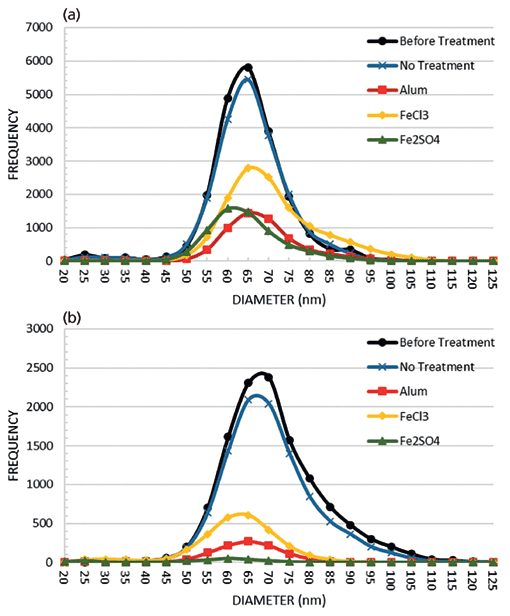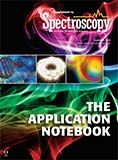The Benefits of SP-ICP-MS to Assess the Fate of Nanoparticles During the Coagulation of Drinking Water
Application Notebook
The continued application of engineered nanoparticles (ENPs) raises concerns about their introduction into natural water bodies via wastewater discharge, incorrect disposal, and leaching from outdoor applications. If discharged into surface water, the fate of ENPs in drinking water treatment processes needs to be evaluated. Coagulation is one of the primary treatments used to remove particles from drinking water; thus, understanding the fate of ENPs during typical coagulation processes is required to accurately predict human exposure. Single particle ICP-MS (SP-ICP-MS) is an important advancement in environmental monitoring of ENPs that has the capability to quickly evaluate size, concentration, and dissolved metal concentration simultaneously with minimal sample preparation.
With many ENPs utilized in consumer products, this work focused on five common varieties: Ag, Au, TiO2, ZnO, and CeO2. The fate of these particles through coagulation processes in two surface water types was evaluated using SP-ICP-MS. Zone 4 coagulation process (aka sweep floc) was used for these experiments. Sweep floc occurs when coagulant is added past the point of solubility, creating insoluble flocs that aggregate. Other particles in the water are attracted to the coagulant flocs and are removed during sedimentation.
Experimental
Citrate-stabilized Ag (40, 70, and 100 nm dia) and Au (50, 80, and 100 nm dia) NPs in 2 mM sodium citrate were purchased from nanoComposix, Inc. (San Diego, CA). Uncoated TiO2 (100 nm), CeO2 (30–50 nm), and ZnO NPs (80–200 nm) were purchased from US Research Nanomaterials, Inc. (Houston, TX), and prepared in DI water. Dissolved Ag, Au, Ti, Ce, and Zn standards in DI water were used to calibrate the instrument.
To simulate coagulation processes, the most commonly used coagulants, including aluminum sulfate, ferric chloride and ferric sulfate, were purchased from Thermo Fisher Scientific, Inc. (Pittsburgh, PA). River water and lake water samples were collected from the Missouri River, and Schuman Lake in Rolla, MO, respectively. Samples were taken from just below the surface, two feet from the bank. Precleaned polypropylene bottles were used to collect samples, and stored in the refrigerator until use.
Instrumentation and SP-ICP-MS Methods
A NexION® ICP-MS with Syngistix™ Nano Software Module (PerkinElmer Inc., Shelton, CT) was used for sample analysis and data processing, using 47Ti, 107Ag, 197Au, 67Zn, 140Ce for quantitation.
Coagulation Treatments
A six-gang stirrer with 2-L square beakers was used for the coagulation treatments (Phipps and Bird). Following the addition of water, 70 nm Au (5 µg/L), 80 nm Ag (2 µg/L), 100 nm TiO2 (6 µg/L), 30–50 nm CeO2 (5 µg/L), and 80–200 nm ZnO (6 µg/L) nanoparticles were added to the beakers and dispersed by stirring. Predetermined amounts of coagulants were added to the beakers and stirred at decreasing speeds to simulate flocculation and sedimentation. Samples were taken immediately after dispersion and after sedimentation to evaluate the change in particle size, concentration, and dissolved ion concentration.
Results
Data demonstrating the change in size distribution histograms of Ag ENPs in river water and lake water after Zone 4 coagulation with three different coagulants are provided in Figure 1. "NO TREATMENT" samples were water matrix with ENPs added and were stirred and underwent sedimentation but did not have coagulant added. "BEFORE TREATMENT" samples were collected from each beaker immediately after the ENPs were dispersed. No obvious shift in size was observed after each treatment. However, the decrease in frequency indicates that the ENPs were removed to some degree after each treatment.

Figure 1: Change in size distribution histograms for Ag ENPs during various coagulation treatments in (a) river water and (b) lake water.
ENP Fate During Coagulation
The change in ENP particle concentration after various coagulation treatments was studied in river and lake water. Particle-size-distribution histograms were generated for each treatment and each particle type. Combined distributions for each particle type are shown in Figures 2 and 3 for river water and lake water, respectively. Particle concentrations decreased after each treatment for all ENPs. The water matrix impacted size distributions, likely due to differences in dissolved organic carbon (DOC). CeO2 ENPs showed greater stability in high DOC lake water compared to lower DOC river water, as indicated by a mean particle size closer to that of the primary particles in the standard. ZnO is known to be highly soluble in water, thus particle size will vary based on water chemistry. In this case, particles aggregated more in lake water compared to river water. In control samples ("NO TREATMENT"), the particle size and concentration was similar before and after treatment for most particles, showing stability between the time of ENP addition and final sampling. ZnO ENPs exhibited dissolution over time when no treatment was applied due to its known solubility in water.

Figure 2: Size distribution histograms for (a) Au, (b) TiO2, (c) CeO2, and (d) ZnO ENPs after Zone 4 coagulation treatments using various coagulants in river water.
Though it won't be discussed in detail here, total ENP removal was improved when polymer was added as a coagulant aid. This result was expected due to the cross-linking nature of the polymer during floc formation. Compared to citrate-stabilized ENPs, uncoated TiO2, CeO2, and ZnO ENPs were more efficiently removed across all treatments in river water, likely due to the lower average surface charge resulting in more charge neutralization and aggregation.

Figure 3: Size distribution histograms for (a) Au, (b) TiO2, (c) CeO2, and (d) ZnO ENPs after Zone 4 coagulation treatments using various coagulants in lake water.
Conclusions
Monitoring ENPs during drinking water treatment is important as their use in consumer and commercial products continues to rise. This work has demonstrated SP-ICP-MS, using PerkinElmer's NexION ICP-MS with Syngistix Nano Software Module, to be a good technique to monitor the particle size and concentration of ENPs in surface waters. This study has also shown that the efficacy of coagulation to remove ENPs from surface waters is an important parameter to consider for risk assessments.
Download the full application note at www.perkinelmer.com/nexion2000

PerkinElmer, Inc.
940 Winter Street, Waltham, MA 02451
tel. (800) 762-4000 or (+1) 203-925-4602
Website: www.perkinelmer.com
